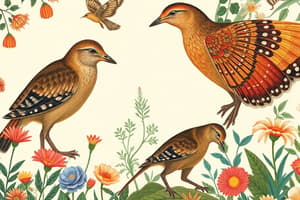Podcast
Questions and Answers
What is an example of an irreversible change?
What is an example of an irreversible change?
- Freezing water
- Melting ice
- Cutting wood (correct)
- Changing colors of leaves
Which stage comes first in the plant growth cycle?
Which stage comes first in the plant growth cycle?
- Seed (correct)
- Seedling
- Mature plant
- Sprout
What adaptation helps fish survive in water?
What adaptation helps fish survive in water?
- Wings
- Long legs
- Gills (correct)
- Fur
Which of these is a unit of measurement used to describe the length of an object?
Which of these is a unit of measurement used to describe the length of an object?
Why is connecting concepts to real-life experiences important in learning?
Why is connecting concepts to real-life experiences important in learning?
What do living things need to survive?
What do living things need to survive?
Which part of a plant is responsible for absorbing water and nutrients from the soil?
Which part of a plant is responsible for absorbing water and nutrients from the soil?
What is one way animals move?
What is one way animals move?
Which of the following is considered a non-living thing?
Which of the following is considered a non-living thing?
What are the five senses?
What are the five senses?
Which of the following describes a simple machine?
Which of the following describes a simple machine?
What reflects how living things respond to their environment?
What reflects how living things respond to their environment?
Which of the following is an example of a change in matter?
Which of the following is an example of a change in matter?
Flashcards
Plant Growth Cycle
Plant Growth Cycle
A series of stages a plant goes through from seed to mature plant.
Animal Adaptations
Animal Adaptations
Features that help animals survive in their environment.
Reversible Changes
Reversible Changes
Changes that can be undone, returning to the original state.
Irreversible Changes
Irreversible Changes
Signup and view all the flashcards
Food for Organisms
Food for Organisms
Signup and view all the flashcards
Living Things
Living Things
Signup and view all the flashcards
Non-Living Things
Non-Living Things
Signup and view all the flashcards
Plant Parts
Plant Parts
Signup and view all the flashcards
Animal Parts
Animal Parts
Signup and view all the flashcards
Plant Growth
Plant Growth
Signup and view all the flashcards
Animal Movement
Animal Movement
Signup and view all the flashcards
Living vs. Non-living
Living vs. Non-living
Signup and view all the flashcards
Basic Needs
Basic Needs
Signup and view all the flashcards
Study Notes
First Grade Science Preparation
- Living Things: Focus on identifying common characteristics, such as needing food, water, and air. Examples of living things include plants and animals.
- Non-Living Things: Understand the differences between living and non-living things. Examples of non-living things include rocks, water, and air.
- Basic Needs: Living things need food, water, and air to stay alive. Discuss in basic term each of the needs.
- Parts of a Plant: Introduce basic plant parts like roots, stems, leaves, and flowers. Explain their functions in simple terms. The role of each part should highlight its impact on the plant's survival.
- Parts of an Animal: Introduce basic animal parts like legs, eyes, ears, mouth, and nose. Explain their functions, like sight, hearing, and movement.
- Plant Growth: Observe and record simple plant growth experiments. Describe how plants grow over time. This could involve measuring and observing changes in the length of plants, the number of leaves, or other measurable indicators. Discuss the different stages of growth in general terms.
- Animal Movement: Observe and record animal movements. Describe how animals move, such as walking, flying, swimming, or crawling. Discuss the reasons or ways animals move, as well as the different kinds of movement.
- Senses: Introduce the five senses (sight, sound, touch, smell, and taste). Briefly explain what each sense does and how it helps animals and humans.
- Basic Weather: Introduce concepts like sunny, rainy, windy, and cold. Use observational examples about how weather changes during the day.
- Simple Machines: Discuss the simplest machines: levers, ramps, and wheels. Explain their use and how they make work easier.
- Changes in Matter: Observe and describe simple changes in some materials, such as a melting ice cube or ripping a piece of paper. Mention if they are easy to reverse or not. Focus on understanding that some materials change.
- Simple Classification: Introduce simple ways of grouping things, such as classifying objects based on their color or shape, or sorting living beings based on noticeable common features. Explain how we can classify.
Further Development of Concepts
- Living vs. Non-Living: Explaining that living things can move and grow are important differentiators. Living things respond to the environment; non-living things do not.
- Basic Needs: Explain how food provides energy and examples of nourishment for different organisms (plants and animals). Discuss the different ways living things get their food.
- Plant Growth Cycles: Introduce the simple cycle of growing a plant (seed, sprout, seedling, plant).
- Animal Adaptations: Introduce the basic idea that animals have features that help them survive in their environment, relating these to different habitats (water, land).
- Changes in Matter: Explain various types of changes. Elaborate on reversible (freezing, melting, changing colors) and irreversible changes (cutting, breaking, burning).
- Basic Measurement: introduce simple units of measurement, such as inches, centimeters, or grams to describe objects or occurrences.
Further Examples and Practical Applications
- Experiments: Discussing simple science experiments could include measuring plant growth rate over a time period, observing different materials' solubility in water, observing the changes in a liquid's state, or categorizing objects by color or shape.
- Observation Activities/Reports of Observations and Results: Encourage students to document their observations during experiments or nature walks.
- Hands-on Activities: Encourage activities to involve the senses, and allow hands-on learning through activities like collecting natural specimens.
Important Considerations
- Age Appropriateness: Adapt the explanations and complexity of information based on the average first-grade student's understanding.
- Visual Aids: Using pictures, diagrams, videos, and real-life examples will significantly improve comprehension.
- Active Learning: Encourage asking questions and engaging with the material through discussions and activities.
- Connection to Real-life: Relate concepts to students' everyday experiences, connecting the science curriculum to what they already know about their daily activities.
Studying That Suits You
Use AI to generate personalized quizzes and flashcards to suit your learning preferences.




